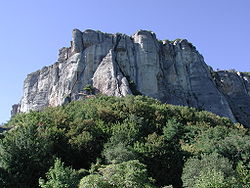
Calcarenite
Encyclopedia

Limestone
Limestone is a sedimentary rock composed largely of the minerals calcite and aragonite, which are different crystal forms of calcium carbonate . Many limestones are composed from skeletal fragments of marine organisms such as coral or foraminifera....
that is composed predominately, more than 50 percent, of detrital (transported) sand
Sand
Sand is a naturally occurring granular material composed of finely divided rock and mineral particles.The composition of sand is highly variable, depending on the local rock sources and conditions, but the most common constituent of sand in inland continental settings and non-tropical coastal...
-size (0.0625 to 2 mm in diameter), carbonate
Carbonate rock
Carbonate rocks are a class of sedimentary rocks composed primarily of carbonate minerals. The two major types are limestone, which is composed of calcite or aragonite and dolostone, which is composed of the mineral dolomite .Calcite can be either dissolved by groundwater or precipitated by...
grains. The grains consist of sand-size grains of either coral
Coral
Corals are marine animals in class Anthozoa of phylum Cnidaria typically living in compact colonies of many identical individual "polyps". The group includes the important reef builders that inhabit tropical oceans and secrete calcium carbonate to form a hard skeleton.A coral "head" is a colony of...
s, shell
Seashell
A seashell or sea shell, also known simply as a shell, is a hard, protective outer layer created by an animal that lives in the sea. The shell is part of the body of the animal. Empty seashells are often found washed up on beaches by beachcombers...
s, ooids, intraclasts
Intraclasts
Intraclasts are irregularly-shaped grains that form by syndepositional erosion of partially lithified sediment.Gravel grade material is generally composed of whole disarticulated or broken skeletal fragments together with sand grade material of whole, disaggregated and broken skeletal debris...
, pellets
Pellets (petrology)
Pellets are small spherical to ovoid or rod-shaped grains that are common component of many limestones. They are typically 0.03 to 0.3 mm long and composed of carbonate mud . Their most common size is 0.04 to 0.08 mm. Pellets typically lack any internal structure and are remarkably uniform in size...
, fragments of older limestone
Limestone
Limestone is a sedimentary rock composed largely of the minerals calcite and aragonite, which are different crystal forms of calcium carbonate . Many limestones are composed from skeletal fragments of marine organisms such as coral or foraminifera....
s and dolomite
Dolomite
Dolomite is a carbonate mineral composed of calcium magnesium carbonate CaMg2. The term is also used to describe the sedimentary carbonate rock dolostone....
s, other carbonate grains, or some combination of these. Calcarenite is the carbonate equivalent of a sandstone
Sandstone
Sandstone is a sedimentary rock composed mainly of sand-sized minerals or rock grains.Most sandstone is composed of quartz and/or feldspar because these are the most common minerals in the Earth's crust. Like sand, sandstone may be any colour, but the most common colours are tan, brown, yellow,...
. The term calcarenite was originally proposed in 1903 by Grabau as a part of his calcilutite
Calcilutite
Calcilutite is a type of limestone that is composed of predominately, more than 50 percent, of either clay-size or both silt-size and clay-size detrital carbonate grains. These grains consist either of fossil fragments, ooids, intraclasts, pellets, other grains, or some combination of them...
, calcarenite and calcirudite
Calcirudite
Calcirudite is a type of limestone that is composed predominately, more than 50 percent, of carbonate grains that are larger in size than sand . The grains can consist of either fragments of fossils, fragments of older limestones and dolomites, other carbonate grains, or some combination of these...
carbonate classification system based upon the size of the detrital grains composing a limestone. Calcarenites can accumulate in a wide variety of marine and nonmarine environments. They can consist of grains of carbonate that have accumulated either as coastal sand dune
Dune
In physical geography, a dune is a hill of sand built by wind. Dunes occur in different forms and sizes, formed by interaction with the wind. Most kinds of dunes are longer on the windward side where the sand is pushed up the dune and have a shorter "slip face" in the lee of the wind...
s (eolianite
Eolianite
Eolianite or aeolianite is any rock formed by the lithification of sediment deposited by aeolian processes; that is, the wind. In common use, however, the term refers specifically to the most common form of eolianite: coastal limestone consisting of carbonate sediment of shallow marine biogenic...
s), beach
Beach
A beach is a geological landform along the shoreline of an ocean, sea, lake or river. It usually consists of loose particles which are often composed of rock, such as sand, gravel, shingle, pebbles or cobblestones...
es, offshore bars and shoals, turbidite
Turbidite
Turbidite geological formations have their origins in turbidity current deposits, which are deposits from a form of underwater avalanche that are responsible for distributing vast amounts of clastic sediment into the deep ocean.-The ideal turbidite sequence:...
s, or other depositional settings.

